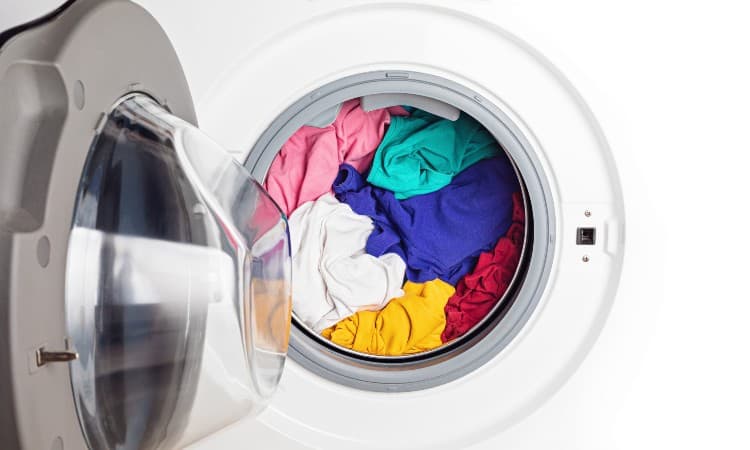Polyester is a common fabric used to make clothing. It doesn’t absorb water or other fluids, leaving many people to wonder, “Does it hold dye or does polyester bleed when it is washed?” If you’re one of those people, hopefully, you’ll have your answer very soon.
Polyester is a synthetic fabric. It is made by a chemical reaction and is derived naturally. Synthetic fabrics like polyester usually hold color better than natural fabrics do. Polyester is less likely to bleed in the washing machine than natural fibers like cotton or wool.
Just because polyester is less likely to bleed, doesn’t mean that it won’t bleed at all. Hopefully, this guide will help you extend the life of your polyester clothing and keep the colors looking vibrant.

How Do You Know if Clothes Will Bleed?
Most people like to know if clothes will bleed before they wash them. The best way to tell if a piece of clothing will bleed is to look at the care label. If it says “wash separately or with like colors”, that’s a good indicator that the color could bleed. Even if the care label doesn’t say to wash separately or with like colors, other factors can determine whether clothes will bleed.
Natural dyes usually hold color better than synthetic dyes. They don’t bleed when washed, nor do they fade as easily! Synthetic dyes are more likely to bleed, and most clothes today are dyed with synthetic dyes. Clothing made of synthetic fibers like polyester – including rayon, modal, and spandex – hold dye better than natural fibers like wool, cotton, and silk. Stick with synthetic fibers to reduce the chances of your clothes bleeding.
Washing your clothes with cool or cold water is better than hot water. Hot water causes the fibers to open up and release the dye. Cold water keeps the fibers closed, trapping the dye inside. Some laundry cleaners like bleach and stain removers can also cause color bleeding. Bleach is designed to remove color, and sometimes stain removers can remove more than just the stain. To be extra safe, use a gentle laundry detergent if you’re worried about bleeding.
How to Test Your Clothes
Colorfast is the ability of a fabric to keep the same color without bleeding when washed. There is a simple test you can do at home to test your clothes for colorfastness.To do a basic test, you will need to wet a clean, white cloth. Turn the item of clothing inside out – if it does bleed, you don’t want it to be noticeable. Rub the wet cloth on the inside of the clothing; around the seam is a good spot. If any color comes off on the white cloth, the clothing will bleed when it is washed.
Some specific laundry detergents or cleaners could cause the color to bleed. To test a specific detergent, mix about a teaspoon of it with ½ cup of water. Dip a cotton swab into the solution, and dab it on an inside area of the clothes you are testing that won’t be seen when worn. Blot the area with a white cloth, if any color comes off then it will bleed.
How Should You Wash Polyester?
Just because polyester is synthetic doesn’t mean it won’t bleed at all. Following the proper steps for washing polyester will help you make sure your clothes don’t bleed and make them last longer. To properly wash polyester, follow these steps.
- Wash with light colors and fabrics.
- Use the normal cycle with cool or cold water.
- Tumble dry on medium heat or air dry.
- If you must iron, use a low-temperature setting.
How to Keep Polyester From Bleeding

Clothes can bleed when washed for many reasons. Most of these reasons have to do with how the clothing was dyed before you bought it. Any of these reasons could be why your clothes could bleed.
- The wrong type of dye was used
- Too much dye was used
- The dye didn’t set properly
Another reason your clothes might bleed is because of the dye itself. Some dyes naturally bleed either when they get wet, interact with certain chemicals, or rub up against something else. Certain colors bleed more than others, so it’s good to know how to keep them from bleeding.
Do Some Colors Bleed More Than Others?
We’ve all had it happen. Our white clothes turned pink because something red was accidentally left in the washer. Red bleeds the most because of the specific kind of dye used for red clothes.
Orange and other bright colors are also prone to bleeding because they are over-dyed to look more vibrant in the store. But with careful laundering, you can keep colors from bleeding in the wash.
How to Wash Clothes to Keep Them From Bleeding

The following tips will help keep all clothes (polyester included) from bleeding in the wash.
- Separate your clothes into lights and darks.
- Turn your clothes inside out.
- Use cold water instead of warm or hot water.
- Throw color catcher sheets into your load to catch dye.
- Wash on the delicate cycle.
- Air dry or dry on low heat.
Besides what is mentioned above, there are different natural ways to stop colors from bleeding in the wash. Here are several and why they work.
Vinegar
While vinegar doesn’t necessarily stop colors from bleeding, it can help restore color to your clothes. Detergent buildup on clothes during the wash cycle can dull fabrics. Vinegar has a lot of acid in it. Adding ½ a cup to 1 cup of vinegar to the rinse cycle can break down detergent buildup in your clothes. This reduces dulling.
Salt
Like vinegar, adding salt to the wash can help stop colors from fading. Add about 1 tablespoon to your laundry load. The chloride part found in salt is thought to help seal in colors.
Baking Soda
In the same way that baking soda can help to brighten your teeth, adding baking soda to the wash cycle may also help to keep your clothes looking bright. Add ½ a cup of baking soda to your laundry to help hold color in.
Does Dry Cleaning Prevent Color Bleeding?
Dry cleaning is most often used on delicate fabrics or clothes prone to shrinking. Dry cleaners use a more delicate washing process than your washing machine at home does. The drum used in dry cleaning is slower and more gentle, and the chemicals used are more gentle as well.
Dry cleaning is also less harsh on colors due to the low temperatures used for washing. Water isn’t used, which is why it’s called dry cleaning. Any water-soluble dyes won’t bleed if they are dry cleaned.
Professional dry cleaners can also “set” the color of your clothes so that they are less likely to bleed. But, if you don’t want to shell out money to have your polyester clothing dry cleaned, you can use a similar process at home to set the color yourself.
How to Set Color Yourself
We’ve discussed how to maintain color when washing your clothes. But, if you want to set the color in new clothing before you wash it for the first time, it can be done fairly easily at home. You will need a large bowl or bucket, water, epsom salt, and white vinegar.
To set the color in your clothes at home, follow these steps.
- Fill a clean bowl or bucket with 2 quarts to a gallon of cold clean water – this can also be done in the washing machine for multiple same color items, but adjust vinegar and salt amounts.
- Add ½ to 1 cup vinegar and 1 to 2 tablespoons of epsom salt to the water.
- Stir the water to distribute the salt and vinegar.
- Place the article of clothing into the water and press it down so that it is full of water.
- Let the clothing soak for 30 minutes. You may notice some color in the water.
- After 30 minutes, dump the old water and refill the container with clean water.
- Put the fabric back in the water. If any color is still coming off, soak it again in the vinegar and salt.
- Let the fabric dry completely and you’re all set!
Should You Wash New Clothes Before You Wear Them?
It is highly recommended that you wash your new clothes before you wear them. According to the laundry experts at Wash, clothing is exposed to all kinds of germs in the store. These germs can come from other people touching the clothes or trying them on and putting them back on the rack.
Touching clothing that other people have tried on and then touching your face puts you at risk of catching an illness. Staph and strep bacteria, as well as fungus and lice, have all been found on clothing in the store.
If that isn’t enough reason why you should wash your new clothes before you wear them, there are also chemicals on some of the clothes. These chemicals are used to process and ship the clothes to keep them fresh. This can cause skin irritation or even an allergic reaction in some people. So wash your clothes before you wear them; it’s better for your health and safety.
Conclusion
Did you find this guide to keeping polyester and other clothing from bleeding helpful? Following these guidelines can help you get the most wear out of your clothes and help them last for a long time.
The suggested methods are easy to do at home, but if you would rather seek help from a professional, you can always take your clothes to be dry cleaned. Comment below if you’ve tried any of these methods, and be sure to share this article if you found it helpful. Thanks for reading!